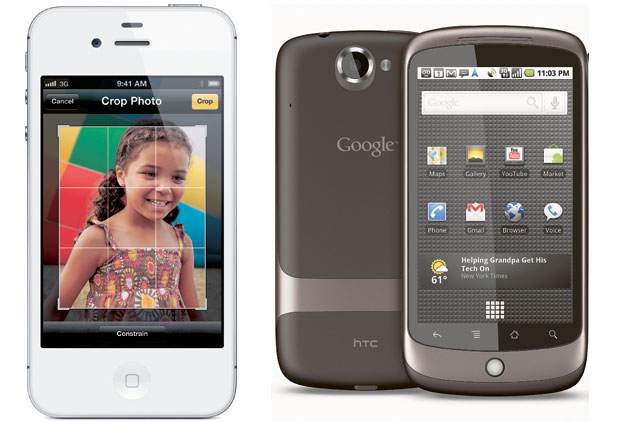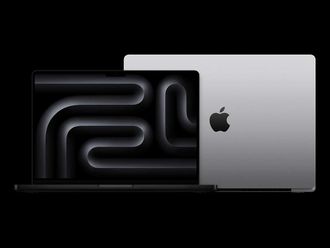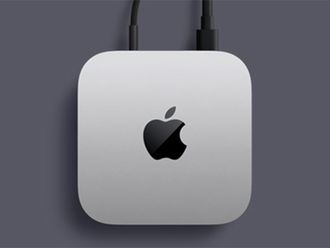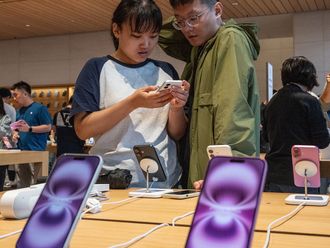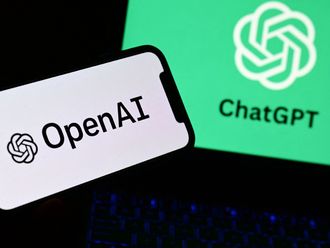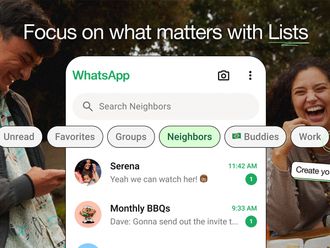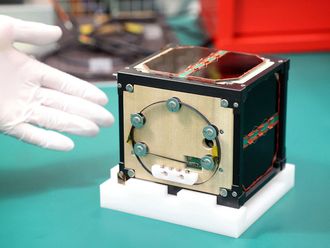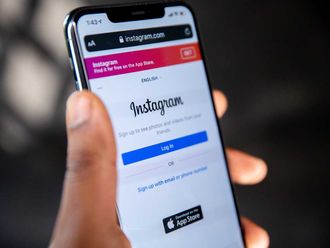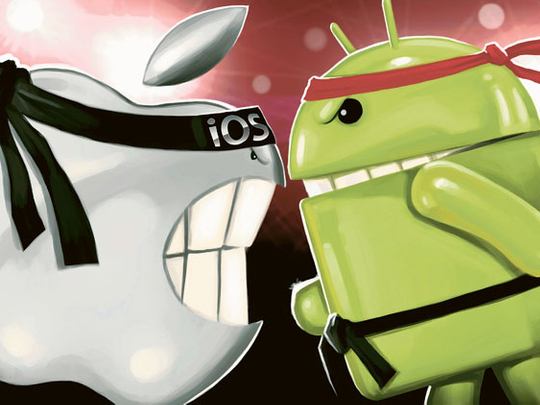
- Apple iOS: David Tusing
Where I Stand
I’ve been an Apple fanboy ever since I bought my first iPod way back when. Ever since, I have slowly and faithfully built my “icosystem”: MacBook, Apple TV, iPad, iPhone et al. Having said that, I’m no Apple Nazi. I’d gladly switch loyalties should there be a better product. But so far there is none in sight.
Strength in numbers
Yes, let’s bring out the big guns. One thing Android fanboys will never bring up in an iOS versus Android argument is the number of apps they have, because they know they will lose. What’s 500,000 less 200,000? My funky calculator app (of which there are more than 500 variations) tells me they’re just 300,000 short of cool. Oh look, there’s an app for an evil laugh.
Quality, not quantity
Once you have won the first round, the Android boys will try to play the freedom-of-choice card and show off the variety of hardware options they have.
Besides six major manufacturers regurgitating an almost endless parade of yawnful devices, none come close to Apple’s mastery of product design. Most Android phones lack polish in hardware as well as software, and that class that comes with stringent quality control — and definitely not from something you dole out for free to every Tom, Dick and Harry in the name of democracy.
Quality control
When Apple does something, it does it properly. Yes, certain features may have taken a while to get on some devices, but this is to ensure that when it does get on, it works well and good. I’d rather have three features that work like clockwork than six that do a half-hearted job of it.
What happens then is the user is left to deal with the problem while the developer goes scot free. Apple insists it vets, controls and approves all the apps that go on its market, leaving you with a properly finished product that works perfectly on your properly designed device.
We’ve got cloud
From October 12, excuse us if we have our head in the clouds. Once iCloud is rolled out, Apple device users will be able to store content in the cloud and wirelessly push it to all other devices, including iTunes music. This means all new contacts, photos, music purchases or calendar appointments will automatically be pushed to the cloud and synced.
Up to ten devices can be grouped for free and with up to 5GB of free storage. And oh, we’re getting our own BBM-style iMessage. And we’re soon going to be able to update our operating system without the need to connect it to a PC. Your turn, Android?
Security
Smartphones and tablets regularly synchronise with home desktop computers and according to security software maker Symentec, Android phone users are more susceptible to malware than iOS-based device users. Android’s reliance on users to grant a set of permissions could cause major security breaches, since a majority of users are not technically equipped to make necessary security decisions.
On the other hand, Apple’s iOS platform does not allow access to many of the device’s more sensitive areas. On Android, a malicious app simply requests the set of permissions it needs to operate, and in most cases, users happily grant these permissions. Their words, not mine.
Gaming
The iPhone and iPod Touch started it and now the iPad. Apple has for ever revolutionised the way we play games on our devices. And now, with the iOS 5 raring to take things to a new level, what with niceties such as photos for friends, turn-based game support, recommended friends and recommended games options, gamers have never had it so good. What gaming did you say Android users? Yeah, we hear you.
The price is right
This might be a bit of an unfair comparison due to the sheer number of Android devices out there, but consider all the points above and put them all (and then some) into one funky device and you’re sure to get the best hassle-free bang for your buck. Did we say a classy device?
Conclusion
So there you have it. When it comes to choosing a device that is near perfect, that looks and feels good, and that fulfils every dirham you have spent on it, Apple’s products trump the competition in all product categories.
This one’s really a no-contest.
David Tusing is the Deputy tabloid! Editor and the team’s resident “geek chic”, as he likes to modestly call himself. When he is not on the front row of a catwalk show tapping away on his iPhone or iPad, he’s debating the finer points of social media with anyone who cares to listen. He likes Bollywood but won’t break into a dance even if you threaten him. He’s on Twitter at @DavidTusing.
- Google Android: Bhavishya Kanjhan
Where I Stand
Hi, my name is Bhavishya and I’m an Android fanboy. There, I said it, and I am not ashamed of it. I have no reason to be. I have owned the first Android phone, the G1, had a BlackBerry in between (didn’t enjoy it) and moved back to Android with a Nexus One. I’m eagerly awaiting the Nexus Prime and here’s why.
Choice
Unlike the iPhone, which adopts a one-size-fits-all approach, Android gives you choice and free will. Pick your screen size — large screen, small screen, vertical screen, horizontal screen. How about keyboards — slider keyboard, candybar keyboard. Heck, you can even choose your software keyboards — Swype, BetterKeyboard, SlideIT. Maybe you want a camera with a higher resolution? Whatever it is you want — you have the freedom to select.
Affordability
Yes, I understand “affordable” is subjective, which is exactly why Android is affordable. You can afford a sub Dh1,000 Android phone and afford a Dh2,500 phone. The iPhone, on the other hand, comes with a single price, with a large chunk being Apple tax.
Bluetooth sharing
Hello, iPhone? Yes, it’s the year 2000. We were wondering if you had implemented a technology from our time yet.
No really, you can’t share images or anything else with your friends via Bluetooth. So you either have to be connected via WiFi or have a data package to send an e-mail with the content. Android, on the other hand, allows you to share what you may well please over Bluetooth.
In fact, apps can be deeply integrated into the system so you can share or send a photo with any of these applications. So take a picture and add it as a task, scan a QR code and send it as an e-mail. This is how a real operating system works.
USB storage
Your iPhone has 8/16/32 GB of capacity, but can you really use it the way you want? Probably not. The Android phones let you use it as a USB drive. Plug in a cable and you have extra storage capabilities to copy “important files” from a friend’s place. And with the standardisation of connectivity with Micro USB ports — there’s a compatible cable in practically every house. Camera, phones and more — all have the same cable.
Not tied to iTunes
Want to transfer music to an iPhone? Use iTunes. Want to transfer video? Use iTunes. Anything else? Use iTunes. You’re practically chained to this slow, sluggish piece of software to do just about anything. Android phones, on the other hand? Copy and paste music and videos on to the drive, it shows up just fine. The USB storage comes as a godsend.
Widgets
Want to check the weather? Fire up the weather app. What’s happening on Twitter? Start the Twitter app. Maybe you want to see how those stocks are doing? Let’s start another one. Time is money and the switching cost is, as my dad would say, “criminal expense”.
Set up a home screen with widgets and see everything you want on one page. Hey, even put up a nice photo frame of your loved one(s) or pet there. Widgets for applications let you take a quick action, such as updating your status message or adding a task, without the need for firing up an application.
Removable storage and battery
All modern smartphones are huge battery burners. With large touchscreens, 3G connectivity, GPS capabilities and powerful processors, the battery life of modern phones has reduced dramatically in recent years. The iPhone won’t make life any easier for you, requiring you to charge your phone every time it dies out. With Android phones, on the other hand, you can pop a new battery in. Not everyone carries a spare battery, but it’s nice to have the option to do so, no? The same goes for storage — running out, of space on your Android phone,.Buy another SD card and pop it right in.
Conclusion
All the points I’ve made have an underlying theme — freedom. Yes, Steve Jobs took away what our ancestors across many cultures fought for. OK, maybe that’s a tad dramatic, but the principle remains: The Android platform lets you choose a phone based on your taste, and use it the way you want to. After all, you paid for it.
Bhavishya Kanjhan is a Dubai-based digital marketing professional and a regular contributor to tabloid! on Saturday’s technology page Switched On. His interests lie in mobile marketing, augmented reality and social media, but if the situation demands, he can also break into a Bollywood dance number. He can be found at @Bhavishya on Twitter.


